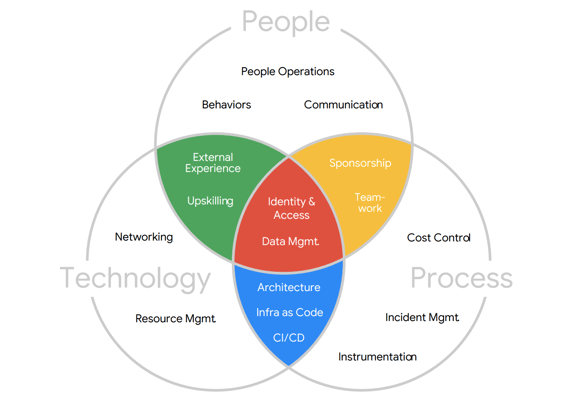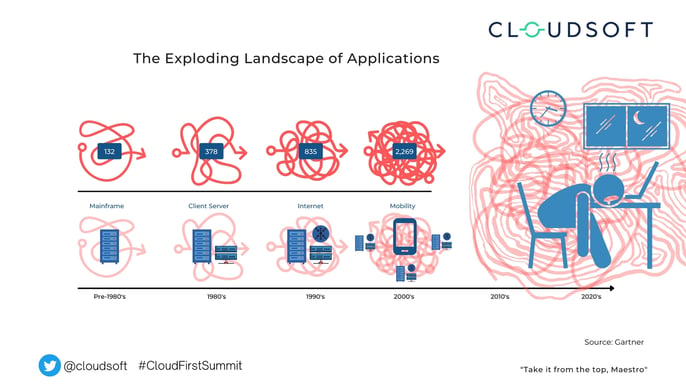Cloud, complexity & collaboration: lessons from DIGIT's Cloud First Summit
/14.png?width=200&name=14.png)
Speaking yesterday at the DIGIT Cloud First Summit, I noticed two overarching themes:
- The need for new models that are more suited for digital and cloud solutions;
- Complexity , driven by dramatic growth in cloud, that requires solutions that encompass people, process and technology.
Cloud and the digital business
It wouldn’t be a 2021 cloud conference if there weren’t multiple references to the impact of the pandemic on cloud adoption! Speakers noted how Covid-19 forced acceleration in cloud adoption plans in order to cope with the huge shift to online operations. Our slow return to (the new) normality poses challenges, as those cloud pioneers within organisations find themselves battling against rigid business processes built for more predictable times.
Kylie Fowler, of ITAMIntelligence, suggested a lot of lessons could be learned from FinOps, to marry business processes and the adoption of new cloud solutions, services and skills. Whereas DevOps seeks to align practices within technology teams, “FinOps takes the rigour of financial management and aligns it with the ethos and agility of cloud”; in short, it sees cloud as a facilitator of a digital business model not just as a technology solution.
A cross-functional culture, as embodied by FinOps, is essential to cloud adoption and cloud maturity. Kylie’s perspective was that Cloud Service Providers can sometimes overlook these cultural aspects within their own adoption frameworks, citing Google’s as an example of where the technology adoption is core, and the cultural adoption is peripheral - a ‘not for now’ concern:

Source: Google Cloud Adoption Framework
This might work in times of extreme, such as 2020, but it isn’t just technology teams who need to ‘Adopt and Adapt’ when it comes to bringing cloud into the business. We see this all the time when speaking to customers, and usually find when doing architecture reviews or strategy and adoption sessions that there are bigger, cultural challenges within organisations that need to be addressed.
You can learn more about our Well Adopted and Well Migrated services here, and get our Five Top Tips for getting Cloud Adoption right.
Complexity
The second big theme cropping up throughout the day was the complexity organisations now have to deal with. Chris Patten, of Centrica, spoke vividly on the 4 eras of computing:
- Simple
- Complex
- Simulated (cloud)
- Cybernetic
As we accelerate into the cybernetic era, with its interactive blend of people, process and technology, we will need ways to manage, map and control each of these pillars holistically. Emerging technologies such as hyperautomation are an example of how people, process and technology become blurred as, in this case, automation moves from being process driven to acting as an extension of humans in their day to day life.
My own talk looked at how, as we’ve moved from the Complex era to the Simulated era and into the Cybernetic era, the IT landscape, and the application landscape has exploded:

The diagram above shows the average count of applications at enterprises, and the growth of infrastructure and platforms, through the years, and I suspect that it’s now so large that Gartner simply stopped counting.
Most, if not all, enterprises are now operating an extensive hybrid environment, not only with applications running in clouds, on-premises and at the edge, but also increasing numbers of new DevOps and Lifecycle management tools across the whole lifecycle. But if you strip conversations about technologies back to what the application needs, you can start to see a path through the chaos. This application-centric approach is top-down, focusing on how you package up your applications as digital business capabilities and deliver them to your customers, rather than the infrastructure and platforms you’re running them on.
We call this approach Estate Orchestration, and it’s a dramatic evolution on how we manage infrastructure today. Gartner recommends tooling they're calling a Digital Platform Conductor (DPC) to deliver this orchestration.
Final thoughts
There is a connection between these two themes, and that is how every business is a technology business and technology is everyone’s job - whether they be a builder or a user. The extension of technology in practice also needs to filter through into the culture of the organisation, which is where Composability comes in.
In the Composable Business, the business rejects monolithic solutions in favour of more agile ‘building blocks’ which can be assembled by the business unit consuming the application.
Gartner sees composability as one of the Top 10 Strategic Tech Trends for 2021: Businesses see composability as a way to cut through the complexity we’ve created to more useable, repeatable, understandable and visible parts tied to business priorities, and financial practice, so we can construct these in new ways, with agility. By doing this we’ll then rapidly be able to evolve the Business-IT relationship to become ever more collaborative.
Read more about composability here.
The main take aways were the need for collaboration and composition to become the key pillars of tackling the continued growth in our environment and taming the complexity of our environments - bringing people, process and technology together.
Want to learn more about conducting, composing and orchestrating your technologies?
Come to our event on 22nd July!

